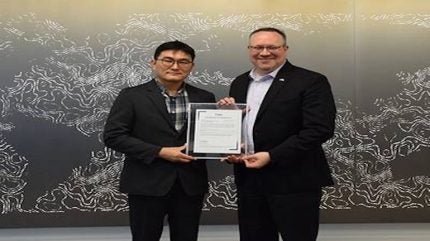
A nuclear propelled containership designed by HD Korea Shipbuilding & Offshore Engineering (HD KSOE) has received approval in principle (AIP) from the American Bureau of Shipping (ABS). Following the AIP, HD KSOE will continue to work with ABS to further develop the vessel. ABS is working with the US Department of Energy (DOE) to research barriers to the adoption of advanced nuclear propulsion on commercial vessels.
The design is for a 15k TEU vessel. A twenty-foot equivalent unit (TEU) is the standard measure indicating how many 20-foot-long containers can fit on a particular container ship. The design uses a molten salt reactor (MSR) propulsion system for heat and a supercritical carbon dioxide (SCO2) system for power generation. ABS completed design reviews based on class requirements. The high operating temperature of molten salt reactors allows for efficient heat transfer, and they are considered inherently safe due to their liquid fuel which can be drained in case of an emergency.
“Advanced modern reactors are both a global decarbonisation solution and a commercial shipping disruptor,” said ABS Chairman & CEO Christopher J Wiernicki. “They are a key transformational technology that forms a critical part of the calculus to get to net zero by 2050 and they change the commercial model, the economics of shipping, the operation of the vessels and their design, as KSOE have demonstrated. The new nuclear story is now being written and this collaboration with KSOE is an important step forward.”
HD KSOE Senior Vice President Sangmin Park said: “Fourth-generation SMRs, currently in the demonstration phase, offer a groundbreaking improvement in safety compared to conventional reactors. When applied to large container ships, they could potentially have less risk than some of the other alternative fuel systems.”
October 2024 saw publication of the 70-page ABS Requirements for Nuclear Power Systems for Marine and Offshore Applications, which provides the first classification notation for nuclear power service assets such as floating nuclear power plants or nuclear-powered floating production, offloading and storage units. ABS also released a 14-page study, Pathways to a Low Carbon Future LNG Carrier Nuclear Ship Concept Design. investigating the potential of advanced nuclear technology for maritime applications, with a study of a small modular reactor (SMR) on a standard liquefied natural gas (LNG) carrier. This modelled the impact of a high-temperature, gas-cooled reactor (HTGR) on the design, operation and emissions of a 145,000 cubic metre LNG carrier. It was undertaken jointly with Herbert Engineering Corporation.






